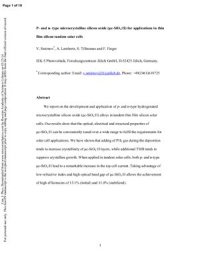
Ebook: P - and n - type microcrystalline silicon oxide (μc-SiOx: H) for applications in thin film silicon tandem solar cells
Author: Smirnov et al.
- Genre: Physics // Solid State Physics
- Tags: Физика, Физика твердого тела, Физика полупроводников
- Language: English
- pdf
IEK-5 Photovoltaik, Forschungszentrum Jülich GmbH, 2004. — 18 S.
We report on the development and application of p- and n-type hydrogenated microcrystalline silicon oxide (μc-SiOx:H) alloys in tandem thin film silicon solar cells. Our results show that the optical, electrical and structural properties of μc-SiOx:H can be conveniently tuned over a wide range to fulfil the requirements for solar cell applications. We have shown that adding of PH3 gas during the deposition tends to increase crystallinity of μc-SiOx:H layers, while additional TMB tends to suppress crystalline growth. When applied in tandem solar cells, both p- and n-type μc-SiOx:H lead to a remarkable increase in the top cell current. Taking advantage of low refractive index and high optical band gap of μc SiOx:H allows the achievement of high efficiencies of 13.1% (initial) and 11.8% (stabilized).
We report on the development and application of p- and n-type hydrogenated microcrystalline silicon oxide (μc-SiOx:H) alloys in tandem thin film silicon solar cells. Our results show that the optical, electrical and structural properties of μc-SiOx:H can be conveniently tuned over a wide range to fulfil the requirements for solar cell applications. We have shown that adding of PH3 gas during the deposition tends to increase crystallinity of μc-SiOx:H layers, while additional TMB tends to suppress crystalline growth. When applied in tandem solar cells, both p- and n-type μc-SiOx:H lead to a remarkable increase in the top cell current. Taking advantage of low refractive index and high optical band gap of μc SiOx:H allows the achievement of high efficiencies of 13.1% (initial) and 11.8% (stabilized).
Download the book P - and n - type microcrystalline silicon oxide (μc-SiOx: H) for applications in thin film silicon tandem solar cells for free or read online
Continue reading on any device:

Last viewed books
Related books
{related-news}
Comments (0)